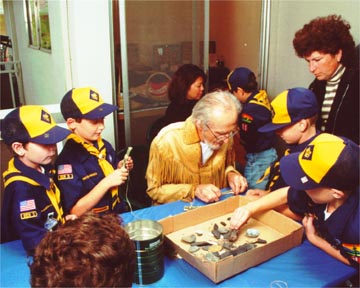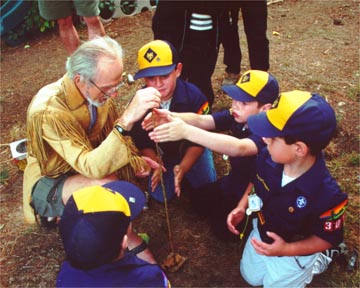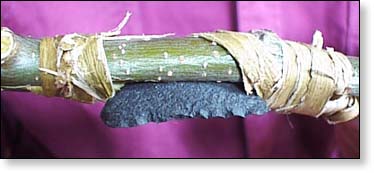
Why It's Important
Everyone finds it easy to complain about what is taught in our public schools but how many people take the opportunity to actually do something about it? I am fortunate enough to work for a large company, one of whose corporate objectives is to be a good citizen of the community. This is interpreted fairly broadly. In my case it means I take time off during my regular work hours to go into the local public schools and show students the material culture of everyone's stone age ancestors as well as that of the local Native Americans (Ohlone Tribe) of the San Francisco Bay area in California. I make up the lost work time whenever convenient.

This article is not a "how to do it' but instead it is a "what you can do" or "what's possible". It assumes the reader is already skilled in some aspects of primitive living skills and is interested in passing them on to young people.
Why do I teach primitive skills? With all the "practical" things that children need to learn to survive in the heart of Silicon Valley, why should they learn all this primitive stuff? Lots of reasons:
They live in a multi-cultural world. There are at least 15 different languages spoken in the local schools. This stone age heritage is one thing that everyone shares, a common bond between children whose ancestors came from North America, South America, Europe, Africa and Asia. I hope that realizing this would be a unifying factor for the students.
They need to balance knowledge with experience. By their nature and by the practical constraints of having to teach 25 to 30 students, most grade school teachers must emphasize knowledge which can be quantified and put down on paper: essays, arithmetic work sheets, etc. This is fine for many children. What about those students who are more at ease expressing themselves by making something with their hands? These are the people who will grow up to be the engineers, mechanics, carpenters who keep our society "working". The message needs to get out that there are many types of skills and knowledge beyond what can expressed on a 2-dimensional piece of paper. It is my hope that by showing the students things that Ohlone children and their own stone age ancestors made with their hands they will gain a greater appreciation of what they can do for themselves.
They need positive values. I am really concerned abut children who spend too much time in front of television sets, playing video games, being car pooled from piano lessons to Little League Baseball to Scouts to ballet lessons to soccer league . . . I would hope that exposing them to some of the ancient crafts would make them more resourceful and self-sufficient.
They need to know their history. How can you tell where you're going unless you know where you came from? Camille Paglia said "Education has become a prisoner of contemporaneity. It is the past, not the dizzy present, that is the best door to the future."
They need to learn natural skills. When I look a little deeper, we aren't teaching the students how to make cordage, toys and stone tools. We are teaching them to manipulate tools and materials. This is something that transcends time. It is as important now as it was 50,000 years ago.
General Principals
Deal in tangibles. Things students can get their hands on, make, do. I let other people tell stories and teach them games. I want as many as possible to be able to take something home that they made with their hands. I want as many as possible to get their hands on and manipulate different materials.
Try to keep ego out of it. Less time listening to me talk means more time for them to actually do things themselves.
Teach teamwork.

I have a limited amount of time so it is impossible to teach everything to everybody. Therefore I will teach a few students how to do something and then ask those students to teach the rest of the class later if they have time. A second technique is to arrange projects so that several people are involved. Examples of that are cordage making and fire-by-friction.
Prepare students in advance. The students must have some background lessons in either the culture of the local Native Americans or hunter-gatherers. You won't have the luxury of time so you'd better be ORGANIZED.
Specific Things I've Done In Schools
A scenario: A fourth grade class has been studying the pre-European-contact culture of the local Ohlone tribe. Today boys and girls read printed matter. I pull out a quail call made from a split stick and a blade of grass and do a few calls. What is it? It usually takes a lot of guessing before they figure out what sound it is. Conclusion: Ohlone boys and girls were much better at recognizing the calls of wild animals.
A string figure: Ohlone houses were dome shaped (no snow here in Palo Alto). Native American dwellings in the Sierra Nevada mountains were cone shaped to better resist the weight of snow. There is a very simple string figure which looks like a cone shaped house with smoke coming out of the top.
Team cordage: Another universal commodity. To paraphrase Steve Watts "The world of the Ohlone was held together with string and rope". Get the pupils to name some of the things for which the Ohlone used string and rope. Unless they know what the cordage is going to be used for the making of cordage is an abstract exercise which often leads to very poor workmanship. I bring a small model of a Peruvian reed boat and a photo of a contemporary replica of an Ohlone-style tule boat. Limits of time: I have only 10-15 minutes to show them how to make cordage out of shredded cattail leaves. I involve 2 "helpers". One holds the twined cord up while the other helper and I give each strand a twist and pass it on to each other. Out of all the nine or so different methods of making two-ply twined cordage this is the easiest to learn and another big advantage is that it is a cooperative effort. As they become more skilled they will see how they can do it on an individual basis. I teach 2 people how to make cordage and then those two teach the rest of the class after I leave.
The "Hoko" Knife: This is an activity for the "stone age overnight." In sixth grade social studies in California there is a unit on hunter-gatherers. One teacher takes them to a local park for a stone age over night where they cook their meals on an open fire, make shelters and learn some stone age living skills. They've read and heard about flintknapping and want to try it but in an hour what could they learn? I tell them one of the realities of stone age living is that only a tiny fraction of all stone tools and weapons were delicately and finely flaked. The majority of the stone tools used by our ancient ancestors were simple flake tools, made in a few seconds, used until dull and then thrown away. The prototype stone tool that I have the students make is a "Hoko" knife. This tool is a rough copy of a simple hafted stone flake found at a 2,700 year old archaeological site on the Hoko River of Western Washington State.

The "Hoko" knife is simplicity itself. For the handle, select a piece of green willow or other tough, flexible wood that is about as thick as your finger. It needs to be about two hand spans long. Use a big piece of sharp rock to notch the stick in two places and break it to length. Next, split it down the middle with a wooden or antler wedge. Bind the split halves together at one end (a practical use for the cordage they learned to make). Spread the split apart and insert a sharp stone flake as close to the binding as possible. Squeeze the other ends of the split handle together and bind. This should give you a sharp stone edge held very tightly in a wooden handle.
Fire by Friction: This is an activity whose objectives go far beyond lighting a fire. Primarily it is a lesson in cooperation and teamwork. I try to get as many hands as possible involved. In the case of a hand spun fire drill I have 4 young helpers take turns on the spindle. We go easy at first and then I take over and twirl with maximum effort to get a glowing ember. Once the ember is glowing I have the entire class form a big circle and I walk around the circle with the smoldering tinder bundle so that everybody can help blow on it to bring out the flame. Everyone contributes. I explain to them that because I am no longer young I barely have the stamina to do it by myself and they are still too young to have developed the skill and stamina required to start a fire. When we work as a team we can achieve what none of us could do as individuals.
Acorn tops: Easy and fun. Simply poke a sharp stick in the top of an acorn and spin.
Spit-Willow Deer Figures: I have probably demonstrated and had more students make little deer figures out of tules than out of willow as described in the SPT Bulletin (#8). The reasons are very simple. Tules are easier to acquire and being more flexible they are easier to shape.
A Fourth-Fifth Grade Tule Canoe: Yes, 4th-5th grade students can, with a little adult help, make a tule canoe. This is the watercraft which was used by the Native Americans of the San Francisco Bay region before European contact. Halima Van Tuyl, a teacher at Juana Briones grade school in Palo Alto, contacted me and asked for help on this project. What an opportunity! One weekend in October, when the tules (Scirpus acutus) and cattails (Typha sp.) were at their optimum, a group of parents and students went to the local marshland and cut a sufficient quantity to make our boat. We had one pile of cattails that was about 6 feet (2 meters) in circumference. These would be used for the rope although some contemporary tule boat makers prefer to use tules for the cordage. We cut enough tules to make three bundles 6 feet in circumference and 9 feet (3 meters) in length. For maximum strength and flexibility the cattail leaves should be separated from each other to facilitate drying. Cattails should be dried and then re-dampened before twining them into rope. The ropes were about as thick as my thumb. Ten or twelve ropes were needed, each about 25 feet (8 meters) long, for tying the bundles of tules together. We needed one day to build the boat and the next day was spent paddling it.
Atlatls and darts: Just the thing for little savages. The challenges here are to have equipment which the students can learn to use easily and quickly and to have a process which insures safety. For the former I use a relatively short atlatl, 16 inches (.38 meters) long with a wrist strap and light flexible darts with feathers for stabilization. The main two safety issues are to avoid throwing when someone is near the target and to avoid crowding so that the thrower doesn't reach back and poke someone in the eye with the atlatl. The first problem is solved by having an adult supervisor hold the darts until the student is ready to throw. The second safety issue is solved by having two lines on the ground. The first line indicates where the thrower should stand while throwing. The second line, which is approximately 6 feet (2 meters) behind the first, is the line of death (LOD). The rule is that students must stay behind the LOD until its their turn to throw. This is to keep eyes and atlatls a safe distance apart. If they break the LOD rule, then they are excluded from participation in that activity.
I've described what I'm comfortable doing in a grade school class. Everyone is different. Do what suits you. I've also been purposefully vague on the exact details of how to do these things. That's because there is no uniquely correct way to do them.
REFERENCES
Barrett, S.A. and Gifford, E. W
n.d.
Miwok Material Culture, p 269 & 365
Baugh, Dick
1993
Tule Boats, Bulletin of Primitive Technology. Fall, #6, p 35
Cunningham, Richard W
n.d.
California Indian Watercraft
ISBN 0-945092-01-6
Dilts, Catherine
n.d.
The Ohione Indians
Palo Alto Unified School District Elementary Education Department
25 Churchill Ave., Palo Alto, CA 94306
Elpel, Tom
1994
The Ancient Art of Split Willow Sculpture, Bulletin of Primitive
Technology. Fall, #8, pp 23-28
Kirk, Ruth
n.d.
Exploring Washington Archaeology
ISBN 0-295-95610-0
Southworth-Kidder, Jan
1993 Building of the Kon Tule, Bulletin of Primitive Technology.
Fall, #6, pp 36-41
This article was first published in The
Bulletin of Primitive Technology (Spring 1996, #11)
E-mail your comments to "Richard A. Baugh" at richardbaugh@att.net
We hope the information on the PrimitiveWays website is both instructional and enjoyable. Understand that no warranty or guarantee is included. We expect adults to act responsibly and children to be supervised by a responsible adult. If you use the information on this site to create your own projects or if you try techniques described on PrimitiveWays, behave in accordance with applicable laws, and think about the sustainability of natural resources. Using tools or techniques described on PrimitiveWays can be dangerous with exposure to heavy, sharp or pointed objects, fire, stone tools and hazards present in outdoor settings. Without proper care and caution, or if done incorrectly, there is a risk of property damage, personal injury or even death. So, be advised: Anyone using any information provided on the PrimitiveWays website assumes responsibility for using proper care and caution to protect property, the life, health and safety of himself or herself and all others. He or she expressly assumes all risk of harm or damage to all persons or property proximately caused by the use of this information.
© PrimitiveWays 2013